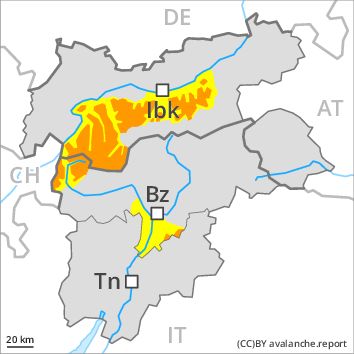Regions
Western Tuxer Alps, Eastern Tuxer Alps, Glockturm Range, Weißkugel Range, Val Müstair Alps, Gurgler Range, Langtaufers, Eastern Nonsberger Alps, Northern Oetz and Stubai Alps, Northern Dolomites of Fiemme

Danger level
Danger Level 3 - Considerable above 2200m
Danger Level 2 - Moderate above 2200m
Avalanche Problem
Wind-drifted snow above 2200m, N-NE-E-W-NW
Gliding snow above 2600m, N-NE-E-SE-S-SW-W-NW

Fresh wind slabs require caution. Below approximately 2600 m gliding avalanches and snow slides are possible.
The fresh wind slabs represent the main danger. They can be released by a single winter sport participant in some cases especially on very steep shady slopes above approximately 2200 m, in particular at transitions from a shallow to a deep snowpack, when entering gullies and bowls for example. The prevalence of avalanche prone locations and likelihood of triggering will increase with altitude. These avalanche prone locations are clearly recognisable to the trained eye.
On steep grassy slopes more gliding avalanches and snow slides are possible, in the regions exposed to heavier precipitation especially.
Snowpack
dp 6: cold, loose snow and wind
dp 2: gliding snow
The snowpack will be moist at low and intermediate altitudes. As a consequence of a strong to storm force southerly wind, wind slabs formed in the last few days at elevated altitudes. In some places wind slabs are lying on soft layers, in particular above approximately 2200 m.
Tendency
Further decrease in avalanche danger.
Regions
Sexten Dolomites, Latemar, Schnals Ridge, Southern Stubai Alps, Southern Zillertal Alps and High Tauern, Saldurn-Mastaun Ridge, Texel Mountains, Southern Adamello, Sarntal Alps, Adamello - Presanella, Western Pfunderer Mountains, Northern Brenta - Peller, Southern Brenta, Southern Lagorai, Northern Lagorai, Maddalene, Pine' - Mocheni Valley, Eastern Pfunderer Mountains, Durreck Range, Western Rieserferner Mountains, Western Deferegger Alps, Central Stubai Alps, Ortler Range, Northern Zillertal Alps, Ulten Valley, Venediger Range, Eastern Rieserferner Mountains, Glockner Range, Gröden Dolomites, Primiero - Pale di S. Martino, Eastern Deferegger Alps, Prags Dolomites, Schober Mountains, Lienzer Dolomites, Fassa Valley, Sole, Pejo and Rabbi

Danger level
Danger Level 3 - Considerable
Avalanche Problem
Gliding snow above 2600m, N-NE-E-SE-S-SW-W-NW
Wind-drifted snow above the treeline, N-NE-E-W-NW

Gliding snow represents the main danger. This applies on steep grassy slopes. Fresh wind slabs require caution, in particular above the tree line.
On steep grassy slopes more gliding avalanches are possible, even quite large ones, in the regions exposed to heavier precipitation especially. This applies below approximately 2600 m.
The fresh wind slabs are in some cases still prone to triggering above the tree line. They can be released even by a single winter sport participant especially on very steep shady slopes. This applies in particular at transitions from a shallow to a deep snowpack, when entering gullies and bowls for example as well as adjacent to ridgelines. The prevalence of avalanche prone locations and likelihood of triggering will increase with altitude. Large avalanches are possible in isolated cases, especially in high Alpine regions.
Snow sport activities outside marked and open pistes call for experience in the assessment of avalanche danger.
Snowpack
dp 2: gliding snow
dp 6: cold, loose snow and wind
Over a wide area 10 cm of snow, and even more in some localities, fell. The snowpack will be moist at low and intermediate altitudes. In some places wind slabs are lying on soft layers, especially at high altitudes and in high Alpine regions. The sometimes strong wind has transported a lot of snow. The fresh and somewhat older wind slabs are in many cases quite large.
Tendency
The danger of gliding avalanches will decrease gradually. The danger of slab avalanches will decrease.


